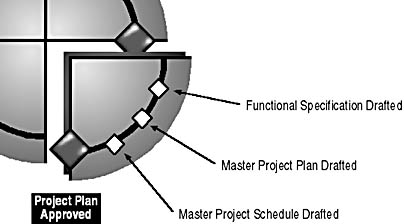Overview of Project Planning
The second of the four phases of the MSF Development Process Model is the Planning Phase, shown in Figure 6.1. It follows the Envisioning Phase, which culminated in the Vision Approved Milestone.

Figure 6.1 MSF Development Process Model Planning Phase
The Envisioning Phase asks the question "Can we use technology to solve this business need, and if so, how?" The result is a common understanding of the problem and a common vision of the solution. The Planning Phase asks the question "Realistically, what will it take to reach the vision developed in the Envisioning Phase?" The result is a detailed plan that both the customer and the project team agree to.
Of all the phases in the MSF Development Process Model, the Planning Phase can be the most difficult to accomplish. The Envisioning Phase is a time of "blue-skying," or exploring possibilities, that is usually exciting, invigorating, and full of energy and enthusiasm. The Developing Phase is a time of hands-on activity, full of the energy of creation, of building, and a feeling of "Now we're getting somewhere!" In between is the Planning Phase, where the dreams of the Envisioning Phase are tested against reality. This phase can be the most emotionally draining of the four phases. It's here that the hard questions are asked: "Which features will get delayed until the next version?" "Which technology isn't yet mature enough to release?" "What cost is too high to justify?" The Planning Phase involves difficult, detailed work, and as a result a project team may be tempted to avoid it or rush it.
The truth is that the work done in this phase will determine the success or failure of the project. It is better to face the truth now, on paper, than to face it later in a failed implementation. The common vision established in the Envisioning Phase has to go through the refining fire of the Planning Phase for the team to be sure that the vision is strong enough to bear up during the Developing and Stabilizing Phases.
Planning Phase and the MSF Design Process
The Planning Phase is the "home phase" for the MSF Design Process, which is outlined later in this chapter. Even though parts of the MSF Design Process can extend outside the Planning Phase, its baseline is established during the Planning Phase. This design baseline is the foundation for the Functional Specification, which is the primary deliverable for the Planning Phase.
Who Does What During Planning?
Although the team works as a whole to achieve the Project Plan Approved Milestone that marks the end of the Planning Phase, individual roles on the team have individual focuses during this phase. Because the primary emphasis is on the MSF Design Process, every role focuses on something to do with design.
Table 6.1 identifies some specific team role responsibilities for the Planning Phase. The lead for each team role communicates these responsibilities to the rest of the project team, and ensures that these responsibilities are carried out.
Table 6.1 Team roles and Planning Phase responsibilities
| Role | Responsibilities |
|---|---|
| Product Management | Drive the requirements-gathering process and the conceptual design process. Work on a communications plan and schedule. |
| Program Management | Drive overall design, specifically the Logical Design. Draft the Functional Specification. Take the overall lead and drive the process of determining whether the team can achieve the plans and schedule. |
| Development | Drive the physical design portion of the Functional Specification. Determine the time and effort required to build and stabilize the product, resulting in the development plan and development schedule. Develop any necessary proof-of-concept systems. |
| User Education | Analyze user needs. Create performance support strategies. Evaluate the completed design for usability. Estimate the time and effort to develop user support systems. Conduct usability testing for all user interface deliverables. |
| Testing | Evaluate the design to determine whether the features test properly. Provide a plan and schedule for testing features. Devise methods and metrics to use in tracking bugs. Develop testing strategies. |
| Logistics Management | Evaluate the design for deployability, manageability, supportability, and total cost of ownership. Devise and set a schedule for deployment plans and support plans. |
Thus, every role on the team is responsible for developing both a plan and a schedule for its particular part of the project. These plans and schedules are then aggregated into two of the Planning Phase deliverables, the Master Project Plan and the Master Project Schedule.
EAN: N/A
Pages: 182